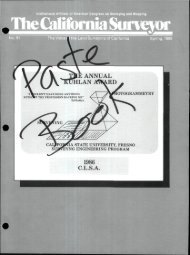The California Surveyor - CLSA
The California Surveyor - CLSA
The California Surveyor - CLSA
Create successful ePaper yourself
Turn your PDF publications into a flip-book with our unique Google optimized e-Paper software.
determine the amount of adjustment<br />
to be made to the remaining existing<br />
network stations. <strong>The</strong> results of the<br />
adjustment (i.e., the newly arrived<br />
at coordinate values for the remaining<br />
NGRS stations) may not be published<br />
for a few years.<br />
Survey Specifics of<br />
HPGN System<br />
<strong>The</strong> <strong>California</strong> HPGN was a joint<br />
project developed and completed by<br />
both the <strong>California</strong> Department of<br />
Transportation (CALTRANS) and<br />
the National geodetic Survey (NGS).<br />
<strong>The</strong> way in which the survey was<br />
planned out and completed may best<br />
be explained if broken down into<br />
three components consisting of the<br />
network design, project reconnaissance,<br />
and data acquisition.<br />
Network Design<br />
<strong>The</strong> initial network design for the<br />
HPGN was planned out on a <strong>California</strong><br />
state highway road map by<br />
the Headquarters Surveys office of<br />
CALTRANS in Sacramento. Since<br />
one of the main reasons for establishing<br />
an HPGN was to allow easy<br />
accessibility to control stations, the<br />
initial approximate locations for the<br />
stations were selected (for the most<br />
part) within state highway rights-ofways<br />
along state highway corridors.<br />
<strong>The</strong> stations were plotted out on<br />
the road map at approximately 30 to<br />
40 mile spacing in a grid pattern<br />
throughout the entire state. <strong>The</strong> final<br />
network layout provided for<br />
about 170 new stations excluding ties<br />
to existing horizontal and vertical<br />
control within <strong>California</strong> or near its<br />
borders.<br />
Project Reconnaissance<br />
Copies of the road map consisting of<br />
the plotted locations of the proposed<br />
new HPGN stations were given to<br />
each of the 12 CALTRANS districts<br />
so that each could go out into the<br />
field and select specific points in the<br />
vicinity of the station locations indicated<br />
on the map. Each district was<br />
responsible for selecting station sites<br />
within their own district boundaries.<br />
In addition to the new stations being<br />
set along the <strong>California</strong> state Highway<br />
rights-of-ways, network design<br />
guidelines and project reconnaissance<br />
called for the inclusion of 5 other<br />
existing groups of stations. <strong>The</strong>se<br />
groups were as follows:<br />
1) All <strong>California</strong> stations in the<br />
National Geodetic Survey's<br />
National Crustal Motion Network<br />
(NCMN). <strong>The</strong>se are order A stations<br />
(10 times more accurate than<br />
HPGN stations) and were used as<br />
control for the HPGN adjustment.<br />
2) Ties to an existing NGRS horizontal<br />
control station in each one<br />
degree by one degree latitude and<br />
longitude block to ensure an interrelationship<br />
between the HPGN and<br />
the existing 16,000 horizontal control<br />
stations.<br />
3) Ties to the existing NGRS<br />
vertical control network to provide<br />
information for orthometric height<br />
determinations throughout the<br />
network.<br />
4) Ties to tidal bench marks to<br />
provide an accurate interrelationship<br />
between the geodetic and tidal<br />
datums.<br />
5) Ties to the southern tier of<br />
stations in the Oregon HPGN project<br />
near the <strong>California</strong>-Oregon border.<br />
Data Acquistion<br />
GPS satellite data was collected by<br />
DISTRICT<br />
01<br />
02<br />
03<br />
04<br />
05<br />
06<br />
07<br />
08<br />
09<br />
10<br />
1 1<br />
12<br />
TOTAL<br />
both CALTRANS and NGS crews<br />
using two primary types of dual<br />
frequency receivers. <strong>The</strong>se were the<br />
Ashtech L XII and the Trimble 4000<br />
SST. Additionally, data collected<br />
from four fixed receiver sites located<br />
at the Mojave CIGNET station, JPL<br />
in Pasadena, Scripps Institution at<br />
La Jolla, and at Pinyon Flat was<br />
incorporated into the project.<br />
Satellite data was collected on all<br />
stations in the network for 6 hours;<br />
and each station was occupied on at<br />
least two different days. All NCMN<br />
stations were occupied on three separate<br />
days and approximately one<br />
fourth of the total number of HPGN<br />
stations excluding the NCMN<br />
stations were occupied three times.<br />
Data for the project began to be<br />
collected on April 5,1991 and it ended<br />
about 4 months later on August 13,<br />
1991. Baseline data reductions were<br />
performed by NGS personnel in San<br />
Diego and in Sacramento by in house<br />
NGS written software (OMNI). <strong>The</strong><br />
baselines were then sent back east to<br />
Maryland where they were reprocessed<br />
using a precise ephemeris for<br />
additional accuracy. A least squares<br />
adjustment was then performed on<br />
all the baselines by NGS and the final<br />
coordinate values released in mid<br />
May 1992.<br />
Table 1<br />
<strong>California</strong> HPGN Network Stations<br />
CALTRANS<br />
STATIONS<br />
15<br />
25<br />
9<br />
12<br />
13<br />
15<br />
6<br />
16<br />
7<br />
12<br />
15<br />
2<br />
147<br />
CALTRANS<br />
NCRS<br />
STATIONS<br />
0<br />
4<br />
3<br />
2<br />
0<br />
3<br />
0<br />
6<br />
10<br />
0<br />
0<br />
0<br />
28<br />
NETWORK<br />
(NCRS)<br />
TIES<br />
2<br />
6<br />
3<br />
2<br />
5<br />
6<br />
0<br />
6<br />
1<br />
3<br />
4<br />
1<br />
39<br />
NCMN<br />
STATIONS<br />
0<br />
2<br />
0<br />
1<br />
2<br />
0<br />
3<br />
2<br />
2<br />
1<br />
5<br />
0<br />
18<br />
TIDAL<br />
BENCH<br />
1<br />
0<br />
0<br />
1<br />
2<br />
0<br />
1<br />
0<br />
0<br />
0<br />
0<br />
0<br />
5<br />
1 2 <strong>The</strong> <strong>California</strong> <strong>Surveyor</strong> Fall 1992

















